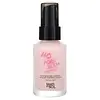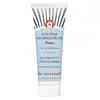What's inside
What's inside
 Key Ingredients
Key Ingredients

 Benefits
Benefits

 Concerns
Concerns

 Ingredients Side-by-side
Ingredients Side-by-side

Cyclopentasiloxane
EmollientWater
Skin ConditioningDimethicone
EmollientDimethicone/Vinyl Dimethicone Crosspolymer
Skin ConditioningPEG-10 Dimethicone
Skin ConditioningDimethicone Crosspolymer
Emulsion StabilisingDipropylene Glycol
HumectantSilica
AbrasivePhenoxyethanol
PreservativeDisteardimonium Hectorite
StabilisingMagnesium Sulfate
Parfum
MaskingMethyl Methacrylate Crosspolymer
CI 77891
Cosmetic ColorantEthylhexylglycerin
Skin ConditioningDisodium EDTA
Aluminum Hydroxide
EmollientStearic Acid
CleansingButylene Glycol
HumectantCI 77491
Cosmetic ColorantSoluble Collagen
HumectantCI 73360
Cosmetic ColorantCamellia Sinensis Leaf Extract
AntimicrobialTriethoxycaprylylsilane
Cyclopentasiloxane, Water, Dimethicone, Dimethicone/Vinyl Dimethicone Crosspolymer, PEG-10 Dimethicone, Dimethicone Crosspolymer, Dipropylene Glycol, Silica, Phenoxyethanol, Disteardimonium Hectorite, Magnesium Sulfate, Parfum, Methyl Methacrylate Crosspolymer, CI 77891, Ethylhexylglycerin, Disodium EDTA, Aluminum Hydroxide, Stearic Acid, Butylene Glycol, CI 77491, Soluble Collagen, CI 73360, Camellia Sinensis Leaf Extract, Triethoxycaprylylsilane
Water
Skin ConditioningCyclopentasiloxane
EmollientCoco-Caprylate/Caprate
EmollientDimethicone/Vinyl Dimethicone Crosspolymer
Skin ConditioningC12-15 Alkyl Benzoate
AntimicrobialButylene Glycol
HumectantGlycerin
HumectantLauroyl Lysine
Skin ConditioningSodium Acrylate/Sodium Acryloyldimethyl Taurate Copolymer
Emulsion StabilisingDimethicone Crosspolymer
Emulsion StabilisingCaprylic/Capric Triglyceride
MaskingMica
Cosmetic ColorantPhenoxyethanol
PreservativeIsohexadecane
EmollientCI 77891
Cosmetic ColorantPolysorbate 80
EmulsifyingC12-14 Pareth-12
EmulsifyingEthylhexylglycerin
Skin ConditioningAloe Barbadensis Leaf Juice
Skin ConditioningDisodium EDTA
Santalum Album Wood Extract
PerfumingCamellia Sinensis Leaf Extract
AntimicrobialChrysanthemum Parthenium Extract
Skin ConditioningGlycyrrhiza Glabra Root Extract
BleachingChlorphenesin
AntimicrobialSodium Hyaluronate
HumectantTin Oxide
AbrasiveCucumis Melo Fruit Extract
Skin ConditioningCucumis Sativus Fruit Extract
EmollientPrunus Armeniaca Fruit Extract
Skin ConditioningPyrus Malus Fruit Extract
Skin ConditioningRose Extract
Skin ConditioningRubus Idaeus Fruit Extract
AstringentTocopherol
AntioxidantPotassium Sorbate
PreservativeSodium Benzoate
MaskingCitric Acid
BufferingSodium Hydroxide
BufferingWater, Cyclopentasiloxane, Coco-Caprylate/Caprate, Dimethicone/Vinyl Dimethicone Crosspolymer, C12-15 Alkyl Benzoate, Butylene Glycol, Glycerin, Lauroyl Lysine, Sodium Acrylate/Sodium Acryloyldimethyl Taurate Copolymer, Dimethicone Crosspolymer, Caprylic/Capric Triglyceride, Mica, Phenoxyethanol, Isohexadecane, CI 77891, Polysorbate 80, C12-14 Pareth-12, Ethylhexylglycerin, Aloe Barbadensis Leaf Juice, Disodium EDTA, Santalum Album Wood Extract, Camellia Sinensis Leaf Extract, Chrysanthemum Parthenium Extract, Glycyrrhiza Glabra Root Extract, Chlorphenesin, Sodium Hyaluronate, Tin Oxide, Cucumis Melo Fruit Extract, Cucumis Sativus Fruit Extract, Prunus Armeniaca Fruit Extract, Pyrus Malus Fruit Extract, Rose Extract, Rubus Idaeus Fruit Extract, Tocopherol, Potassium Sorbate, Sodium Benzoate, Citric Acid, Sodium Hydroxide
Ingredients Explained
These ingredients are found in both products.
Ingredients higher up in an ingredient list are typically present in a larger amount.
Butylene Glycol (or BG) is used within cosmetic products for a few different reasons:
Overall, Butylene Glycol is a safe and well-rounded ingredient that works well with other ingredients.
Though this ingredient works well with most skin types, some people with sensitive skin may experience a reaction such as allergic rashes, closed comedones, or itchiness.
Learn more about Butylene GlycolCamellia Sinensis Leaf Extract is derived from the leaves of the tea plant. Black tea, green tea, and oolong tea are all harvested from this plant.
This ingredient has many skin benefits:
This ingredient contains polyphenols, a strong antioxidant. Antioxidants help fight off molecules that damage skin cells.
On top of that, the antioxidants in green tea neutralize free-radicals from the sun. This gives the skin some extra UV protection, but should not replace sunscreen.
Many components of tea have anti-inflammatory properties.
Polyphenols and L-theanine help soothe the skin and reduce irritation. The caffeine in Camellia Sinensis Leaf Extract helps calm inflamed blood vessels.
Other compounds found in tea include: Vitamin Bs, linoleic acid, magnesium, calcium, iron, and zinc.
Research has shown both drinking Camellia Sinensis Leaf Tea and applying it to the skin can help boost skin elasticity and hydration. Studies also show using tea extract may reduce sebum, or oil, production.
Learn more about Camellia Sinensis Leaf ExtractCi 77891 is a white pigment from Titanium dioxide. It is naturally found in minerals such as rutile and ilmenite.
It's main function is to add a white color to cosmetics. It can also be mixed with other colors to create different shades.
Ci 77891 is commonly found in sunscreens due to its ability to block UV rays.
Learn more about CI 77891Cyclopentasiloxane, or D5, is a silicone used to improve texture of products and trap moisture.
D5 is considered lightweight and volatile. Volatile means it evaporates quickly after application. Once evaporated, D5 leaves a thin barrier that helps keep skin hydrated.
It is also an emollient. Emollients help soften the skin and prevent water loss. Silicones create a silky texture in products. D5 helps other ingredients become more spreadable.
Studies show D5 is safe to use in skincare products. We recommend speaking with a skincare professional if you have concerns.
Learn more about CyclopentasiloxaneDimethicone Crosspolymer is a silicone created by modifying dimethicone with hydrocarbon side chains. Due to its large size, it does not penetrate skin. It is considered non-occlusive.
Dimethicone Crosspolymer is used to stabilize and thicken products. It also helps give products a silky feel.
This ingredient is a silicone used to improve the texture of products and absorb oil. It does not get absorbed into the skin.
Like other silicones, Dimethicone/Vinyl Dimethicone Crosspolymer helps condition the skin by creating a barrier. In this sense, it can act as an emollient and trap moisture in.
This ingredient is a type of elastomer.
Learn more about Dimethicone/Vinyl Dimethicone CrosspolymerDisodium EDTA plays a role in making products more stable by aiding other preservatives.
It is a chelating agent, meaning it neutralizes metal ions that may be found in a product.
Disodium EDTA is a salt of edetic acid and is found to be safe in cosmetic ingredients.
Learn more about Disodium EDTAEthylhexylglycerin (we can't pronounce this either) is commonly used as a preservative and skin softener. It is derived from glyceryl.
You might see Ethylhexylglycerin often paired with other preservatives such as phenoxyethanol. Ethylhexylglycerin has been found to increase the effectiveness of these other preservatives.
Phenoxyethanol is a preservative that has germicide, antimicrobial, and aromatic properties. Studies show that phenoxyethanol can prevent microbial growth. By itself, it has a scent that is similar to that of a rose.
It's often used in formulations along with Caprylyl Glycol to preserve the shelf life of products.
Water. It's the most common cosmetic ingredient of all. You'll usually see it at the top of ingredient lists, meaning that it makes up the largest part of the product.
So why is it so popular? Water most often acts as a solvent - this means that it helps dissolve other ingredients into the formulation.
You'll also recognize water as that liquid we all need to stay alive. If you see this, drink a glass of water. Stay hydrated!
Learn more about Water